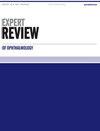The pathogenesis of KERATOCONUS
IF 0.9
Q4 OPHTHALMOLOGY
引用次数: 0
Abstract
The editor, I appreciate the opportunity to respond to Dr Gatinel’s comments as they address some key issues in relation to the pathogenesis of keratoconus (KC). In regard to links between KC and primary open angle glaucoma, Hashemi and coauthors reviewed the associations between KC and posterior segment structures and reported extensive evidence of morphological and functional changes in the retina, optic nerve head and choroid being found in KC patients [1]. These changes included significantly larger disc and cup areas and deeper cup depth in KC patients than in non-KC individuals [1]. It is possible that exposure to rubbing-related or other mechanisms for episodes of elevated intraocular pressure (IOP) might be involved in the development of posterior segment changes observed in KC patients [2]. For instance, increased tissue hydrostatic pressure and ubiquitination processes that could occur during episodes of IOP elevation may help explain both retinal and corneal cellular changes seen in KC patients [2]. Accordingly, increased hydrostatic pressure in corneal stroma may damage keratocytes and reduce their collagen maintenance functions. Poorly maintained collagen may increase the possibility of thinning and reduced resistance to IOP distending forces with associated increased susceptibility for bulging responses during episodes of IOP elevation [2]. In regard to the notion of bulging corneal responses due to IOP forces and an expected increase in corneal surface area: in the earlier stages of KC development, it appears that stromal fibrils/lamellae may not significantly stretch in response to IOP distending forces. That the corneal surface area is conserved can be explained by the concepts of biomechanical coupling [3] or curvature transfer [4]. These explanations involve steepening/bulging/protrusion of a central/para-central/pre-cone corneal area that is less resistant to IOP, which is compensated for by a flattening of curvature in a diametrically opposed area. The lamellae length required to form the bulge is provided by reduced curvature in the flattened zone. Thus, at least in the earlier stages of KC development, corneal surface area is not significantly changed despite a localized steepened area of bulge response. Colour topographical maps of early KC will sometimes very clearly show the compensating flatter peripheral area diametrically opposed to a steeper/bulging/pre-cone central or para-central area. Correction with rigid contact lenses appears to alter corneal topography such that this observation is not often apparent subsequently. KC corneas assume a conical shape in the most advanced cases [5]. and stretching/elongation of stromal fibrils and lamellae may be part of cone formation as well as an increase in corneal surface area. As far as rubbing being the sine qua non mechanism for KC pathogenesis, there is the need to consider patients who don’t have abnormal rubbing habits. For these patients KC development/progression may sometimes be explained by a finding of ocular hypertension especially if combined with having genetically thinner or otherwise weaker corneas which are more susceptible to bulge responses. For any activity which elevates IOP [2], ocular hypertensive patients are exposed to much higher increases in distending IOP forces than those with normal range IOP. Similarly however, for patients with normal range IOP, potentially significant episodic IOP elevations can also be associated with a wide range of common activities [2], Rubbing may be the most important, especially when it occurs as a chronic habit and involves severe forces and associated frequent/longer episodes of very high IOP. But apart from rubbing, much longer duration episodes of lower degrees of IOP elevation may be significant. For example, during extended periods involving prone positions (sleep, sunbathing, back massage or spinal surgery) episodes of elevation up to 40 mmHg have been recorded [6] which could contribute to KC development. Prone sleeping IOP elevation may be exacerbated by contact between an eye and bedding which has been found to elevate IOP by a mean of 22 ± 5 mmHg (peak 40 ± 11 mmHg) [7]. Eye contact with a hand or arm would also exacerbate prone sleep IOP elevations. Of 100 normal control patients presenting for the correction of refractive error, 32% reported daily prone sleeping and 10% indicated sleeping prone as their favorite position [2]. If there is a sine qua non factor in the multifactorial pathogenesis of KC, then rather than just rubbing, it might be a localized steepening/bulging response to elevated IOP distending forces in a thinner/weaker pre-cone corneal area.圆锥角膜的发病机制
编辑,我很高兴有机会回应Gatinel博士的评论,因为他们解决了与圆锥角膜(KC)发病机制有关的一些关键问题。关于KC与原发性开角型青光眼之间的联系,Hashemi及其合作者回顾了KC与后节结构之间的关系,并报道了在KC患者[1]中发现的视网膜、视神经头和脉络膜形态和功能变化的广泛证据。这些变化包括KC患者的椎间盘和杯面积明显大于非KC患者,杯深明显大于非KC患者。在KC患者[2]中观察到的后段改变可能与接触与摩擦相关或其他机制引起的眼压升高有关。例如,在IOP升高期间可能发生的组织静水压力和泛素化过程的增加可能有助于解释KC患者的视网膜和角膜细胞变化。因此,角膜基质中静水压力的增加可能会损害角质细胞,降低其维持胶原蛋白的功能。维持不良的胶原蛋白可能增加变薄的可能性,降低对IOP扩张力的抵抗力,并在IOP升高期间增加对肿胀反应的易感性。关于由于IOP力和预期的角膜表面积增加而引起的角膜膨出反应的概念:在KC发展的早期阶段,间质原纤维/片层可能不会因IOP膨胀力而显着拉伸。角膜表面积守恒可以用生物力学耦合[3]或曲率转移[4]的概念来解释。这些解释包括中心/准中心/前锥体角膜区域变陡/膨出/突出,对IOP的抵抗能力较弱,这是由完全相反区域的曲率变平所补偿的。形成凸起所需的薄片长度由平坦区减小的曲率提供。因此,至少在KC发展的早期阶段,角膜表面面积没有显著变化,尽管局部凸起反应区域变陡。早期KC的彩色地形图有时会非常清楚地显示出补偿性的平坦外围区域与更陡峭/凸起/预锥状的中心或准中心区域截然相反。刚性隐形眼镜的矫正似乎改变了角膜地形图,因此这种观察结果通常不明显。在大多数晚期病例中,KC角膜呈圆锥形。间质原纤维和片层的拉伸/伸长可能是锥体形成的一部分,也可能是角膜表面积增加的一部分。至于摩擦是KC发病的必要机制,有必要考虑没有异常摩擦习惯的患者。对于这些患者,KC的发展/进展有时可以通过高眼压来解释,特别是如果合并了遗传上较薄或较弱的角膜,这些角膜更容易发生凸起反应。对于任何升高IOP[2]的活动,眼高压患者的扩张IOP力的增加要比IOP正常范围的患者高得多。然而,同样,对于IOP范围正常的患者,潜在的显著性发作性IOP升高也可能与广泛的常见活动有关。揉搓可能是最重要的,特别是当它作为一种慢性习惯发生时,涉及严重的力量和相关的频繁/更长时间的高IOP发作。但除了摩擦外,持续时间较长的低IOP升高可能很重要。例如,在长时间俯卧(睡眠、日光浴、背部按摩或脊柱手术)时,血压升高可达40毫米汞柱,这可能会导致KC的发展。俯卧睡眠时眼内压升高可能因眼睛与床上用品接触而加剧,研究发现眼内压升高平均为22±5 mmHg(峰值为40±11 mmHg)。与手或手臂的眼神接触也会加剧易患的睡眠眼压升高。在100名前来矫正屈光不正的正常对照患者中,32%报告每天俯卧睡姿,10%表示俯卧睡姿是他们最喜欢的睡姿。如果在KC的多因素发病机制中存在必要的因素,那么它可能不仅仅是摩擦,而是在较薄/较弱的前锥体角膜区域,由于IOP膨胀力升高而产生的局部变陡/膨出反应。
本文章由计算机程序翻译,如有差异,请以英文原文为准。
求助全文
约1分钟内获得全文
求助全文
来源期刊

Expert Review of Ophthalmology
Health Professions-Optometry
CiteScore
1.40
自引率
0.00%
发文量
39
期刊介绍:
The worldwide problem of visual impairment is set to increase, as we are seeing increased longevity in developed countries. This will produce a crisis in vision care unless concerted action is taken. The substantial value that ophthalmic interventions confer to patients with eye diseases has led to intense research efforts in this area in recent years, with corresponding improvements in treatment, ophthalmic instrumentation and surgical techniques. As a result, the future for ophthalmology holds great promise as further exciting and innovative developments unfold.
 求助内容:
求助内容: 应助结果提醒方式:
应助结果提醒方式:


